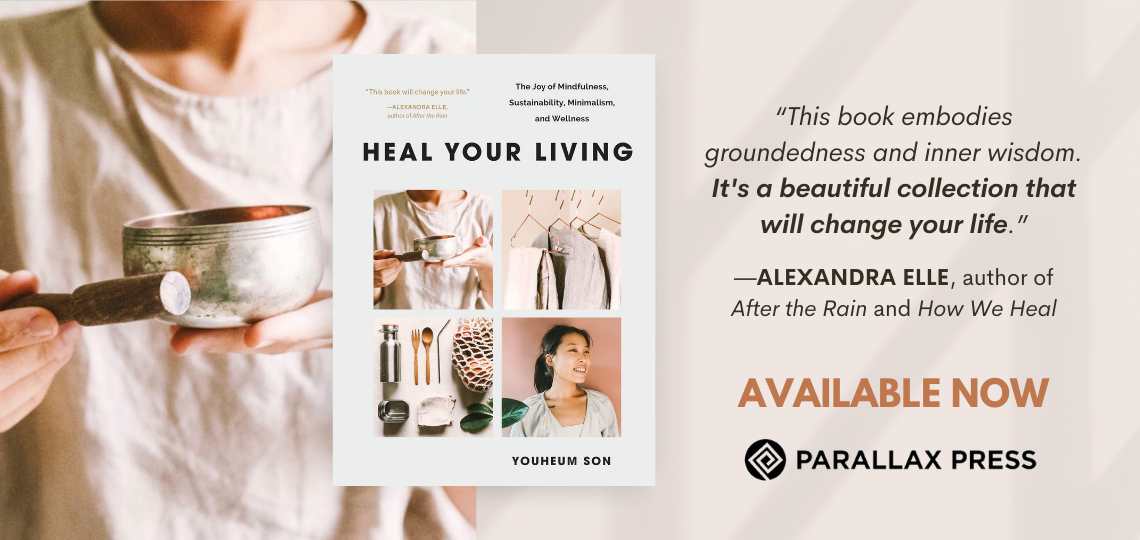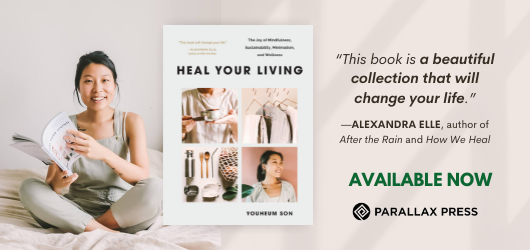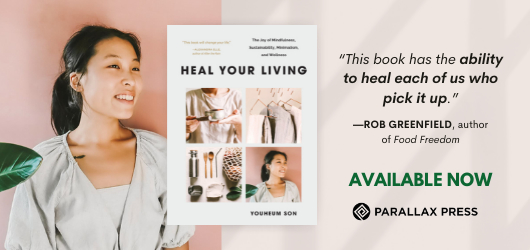Declutter Your Life--Physically AND Emotionally

Executive Editor Matt Sutherland Interviews Youheum Son, Author of Healing Your Living: The Joy of Mindfulness, Sustainability, Minimalism, and Wellness
Creating a healthy and happy life is a daily practice unique to each of us. Countless masters of spirituality have sought to remind their students that change cannot be forced. Rather, it is a process of acceptance, of least resistance, that allows us to discover who we really are.
With great pleasure, we introduce you to Youheum Son, author of Healing Your Living, a wonderful new guide to inner wisdom through letting go. Foreword‘s Executive Editor Matt Sutherland recently caught up with Youheum for the following conversation, one we’re sure you will enjoy.
Your book’s opening chapter, My Journey, details a dramatic before and after. Can you let our readers know what was going on in your life prior to your decision to make profound personal changes?
Before embarking on the journey of letting go, I was living in New York while chasing the dream of material abundance and aesthetic pursuits through hard work and physical efforting. Due to my habit of striving for surface-level success, overworking, and being consumption-driven, I neglected my inner needs to nourish my emotions and spiritual self. Most times, I found myself addictively shopping online, stress eating, binge watching, and seeking artificial pleasure to distract myself from the perfectionist expectation of being externally perfect.
You write that luxuries and material goods can take on a life of their own and feel like they define our worth. Consequently, as part of your growth process, you learned to “release old attachments about status, physical identity, and material association.” Why do you think we develop those attachments in the first place, and can you offer some guidance or exercises to help readers do their own releasing?
I was attached to obtaining a superficial identity through material possession mainly due to the assumption that externalities were the absolute reality on which my entire worth was based. Wearing high-end clothes, taking ownership of expensive goods, and “looking” successful was my life’s purpose for many years because I could not value my intrinsic worthiness on a spiritual level beyond status. My pursuit for consumption was based on seeking what was outside while believing that I lacked what I was looking for elsewhere in profound denial. The artificial means of obtaining perfection was an attempt to “fix” my imperfections and deny the presence of what was already here.
What worked for me to transcend attachment to the unreal and begin reclaiming innate abundance was to restore my self-worth first. More precisely, to believe that I was deserving of change and better decision-making. And this was possible by letting go of the emotional blocks and outdated belief systems that measured my worth based on physicalities. Looking deeply at my internal dialogs attacking my self-worth helped me shed light on my shadows and begin emotionally decluttering, which later manifested into physical lifestyle changes.
Recognizing the human desire to put off and delay, how do you know when the moment is right to begin the healing process and then, take that first step to change?
Delay occurs mainly due to resistance and the belief of “I can’t” or “I shouldn’t.” Casting away these assumptions through firmness of self-trust is the breakthrough most need to set foot on the path of embracing change and begin letting go. There is no set time when it comes to allowing the flow of change; one only has to be willing and stay open without forcibly trying or resisting. I was unaware of when my healing journey began because it felt so natural and unexpected. Thus, it is not necessary to plan excessively but only to be intentional with one’s goal without forcibly controlling the outcomes and striving for the goals.
Explain the advantages of being a beginner?
Any beginner manifesting physical changes through inner work newly embarks on the journey without entering immediately into fixed ideas of how one’s practice must be. They enter with an innocent eye to see what more established practitioners may overlook because much is new to them. Because of this, they are more willing to experiment and go through the ups and downs without needless expectations to do it “right.” When needed, they fall, and they learn to get back up. For this reason, being a beginner has its advantages, and new practitioners do not have to feel discouraged from walking an unpaved path.
You write that the “healing process doesn’t have to interfere with our current lifestyle or threaten the things we cherish.” Which will be a relief to many readers. Can you talk about that specifically?
Many may assume that letting go and living a simple life requires sacrifices, that they must no longer consume material things or live an ordinary sentient life. It is never suggested in the book to relinquish one’s own humanness or the world and its physicalities; it is said that we can enjoy our lives while anchoring ourselves in higher values. We can go about our normal lives and seek pleasurable experiences but do so with mindful awareness, such as speaking intentionally, diving into spiritual exploration, being compassionate to all living beings, and polishing one’s mind.
You identify four essential practices for healing: minimalism, sustainability, wellness, and mindfulness, and explain that each practice “works as an interdependent component promoting growth in the others through the shared goal of harmonizing the mind, body, soul, environment, and lifestyle.” Mindfulness and wellness certainly make sense among those four; sustainability and minimalism, not so much. How do those pursuits facilitate healing?
Sustainability and minimalism are practices focused on compassionate living and mindful awareness of our physical presence on Earth. As spiritual beings navigating the Earthly realm, it is useful to do as much as possible to support those around us. We do not have to force ourselves always to be sustainable or minimal but being intentional with our consumption does create harmony. Whatever we offer to those around us through conscious living, such as lowering waste and consuming mindfully, nourishes all beings because it is an act of servitude and compassion. All lead to the unity of mind, body, and soul through loving gestures.
Chapters come with extensive tools for implementing the healing practices—tips, intention setting exercises, suggestions for personalizing each practice, solution-focused questions, manifestation planning, simple-living vision boards, daily challenges, and much more. Cumulatively, they act like a support group. Please describe how you see your readers engage with these materials?
I focused on providing practical guidance for those willing to explore their inner mechanisms to bring about physical changes. Each chapter provides an opportunity to ponder our habits, routines, and mindset and assess if these align with our higher convictions. Most aim to help readers reflect on what it is they truly want and how they can get closer to their goals by practicing what they desire in the present moment. If they want to feel more focused and productive, they learn to release distractions and let go of clutter to feel their wishes fulfilled without expecting them to be presented in the future. If they want to feel more relaxed, they learn to invite mindfulness and other supportive tools through actual practice.
What I envision for readers is for them to actualize what they want, manifest their fullest without holding back, and believe they can be what they want and live the way they want through continuous experimentation.
You are a big proponent of self care. What is your unique approach to it as outlined in Healing Your Living?
There are two types of self-care: physical support and spiritual. Although physical support assists in lifting our moods and soothing us after a stressful day, what is most important is also to include spiritual self-care, such as prayer, meditation, or contemplation. Seamlessly integrating these practices into our daily schedule helps us remain grounded during passing emotional storms or when we feel distracted by externalities. It is a way of anchoring our mind and heart in the center of inner calm.
Can you also talk about your insights into mindfulness and mindful changes, please?
For me, mindfulness is accepting the flow of the present and yielding to who we internally are without resistance. We flow with the breath, accept our emotions, and become aware of what is here without seeking elsewhere. Change, too, is a way of consenting to what must be and is ready to be accepted. We do not forcibly create change but only accept, just like mindfulness. Many think change is about altering but is actually accepting what we have been calling for but were resistant to. All are practices of embracing our natural selves, in harmony with our higher values such as love and peace without selfishly steering away from what is already available by seeking outside.
What’s next for you and your talented pen?
Writing Heal Your Living was a way to summarize the beginning of my inner work journey and the lifestyle changes that came forth as a result. It was a blessing to be able to reflect on the beginning years of my practice and help those embarking on a similar path. Now, my main focus is to be centered on spirituality and hopefully dive deeper into emotional decluttering; specifically ways to transform fear, anxiety, and stress through mindset shifts, conscious awareness, and inner letting go.
Matt Sutherland



